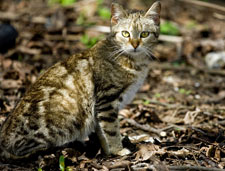|
|
FERAL REMOVAL
 Technically,
feral cats are born and
raised without human contact. Their instincts are highly developed for
survival, so they are extremely fearful of people. Some cats that were
previously owned revert to feral behavior. Some feral are cats have
been lost or abandoned by there owners. Many people erroneously believe
that cats can fend for themselves. Cat owners often abandon their cats
when they move or simply no longer want the responsibility of pet
ownership. Such cats survive only if they find food, shelter, and avoid
dangers such as injury from cars, dogs, other cats, or abusive humans.
They are rarely spayed, neutered or vaccinated, and their offspring are
raised without human contact. Within a few years, one or two cats can
produce a colony of twenty or more. Feral and stray cats live
difficult lives as they are susceptible to disease, starvation and the
freezing conditions of trying to survive a Minnesota winter. Left on
their own, they breed future generations of feral cats who face the
same fate. An estimated 60 million cats are considered homeless in our
country. Feral cats breed frequently, adding to an already overwhelming
pet overpopulation problem. Without intervention, their lives are
filled with danger, disease, hunger, fear, temperature extremes, and
usually end in a slow, painful death. Humane population control of
feral cats is a crucial step in preventing suffering and proliferation.
If you have feral cats on your property the worst thing you can do is
to feed them, before you know it you will be overwhelmed with hungry
cats looking for a free hand out. If you let your cat roam freely
outdoors, PLEASE have the animals neutered or spade. Technically,
feral cats are born and
raised without human contact. Their instincts are highly developed for
survival, so they are extremely fearful of people. Some cats that were
previously owned revert to feral behavior. Some feral are cats have
been lost or abandoned by there owners. Many people erroneously believe
that cats can fend for themselves. Cat owners often abandon their cats
when they move or simply no longer want the responsibility of pet
ownership. Such cats survive only if they find food, shelter, and avoid
dangers such as injury from cars, dogs, other cats, or abusive humans.
They are rarely spayed, neutered or vaccinated, and their offspring are
raised without human contact. Within a few years, one or two cats can
produce a colony of twenty or more. Feral and stray cats live
difficult lives as they are susceptible to disease, starvation and the
freezing conditions of trying to survive a Minnesota winter. Left on
their own, they breed future generations of feral cats who face the
same fate. An estimated 60 million cats are considered homeless in our
country. Feral cats breed frequently, adding to an already overwhelming
pet overpopulation problem. Without intervention, their lives are
filled with danger, disease, hunger, fear, temperature extremes, and
usually end in a slow, painful death. Humane population control of
feral cats is a crucial step in preventing suffering and proliferation.
If you have feral cats on your property the worst thing you can do is
to feed them, before you know it you will be overwhelmed with hungry
cats looking for a free hand out. If you let your cat roam freely
outdoors, PLEASE have the animals neutered or spade.
Feral
Cat Control
When feral cats take over your property Nuisance Bat and Wildlife Control can
handle the problem. If the problem cat belongs to a neighbor please
call your local animal control or better yet talk to your neighbor, we
do not trap domestic cats, dogs or other privately owned animals, if
you can approach the animal it probably has an owner. Nuisance Bat and Wildlife
Control will only use humane traps to capture the feral animals. These
animals will be delivered to the nearest Animal shelter. Some of these
shelters practice trap, neuter, vaccinate, & release (TNVR) and
have there own release sites. Some will try to rehabilitate and adopt
the animals; other will euthanize all feral animals. I have no control
with what the animal shelters do with the wild animals after we deliver
them. Most feral cats will live under your deck, under a shed or in
your wood pile.
Diseases
Stray cats are a source of fatal and non-fatal diseases transmittable
to humans and domestic cats, including rabies, plague, ringworm,
toxoplasmosis, cat scratch fever, allergies, feline leukemia, feline
distemper and secondary bacterial infections.
|

